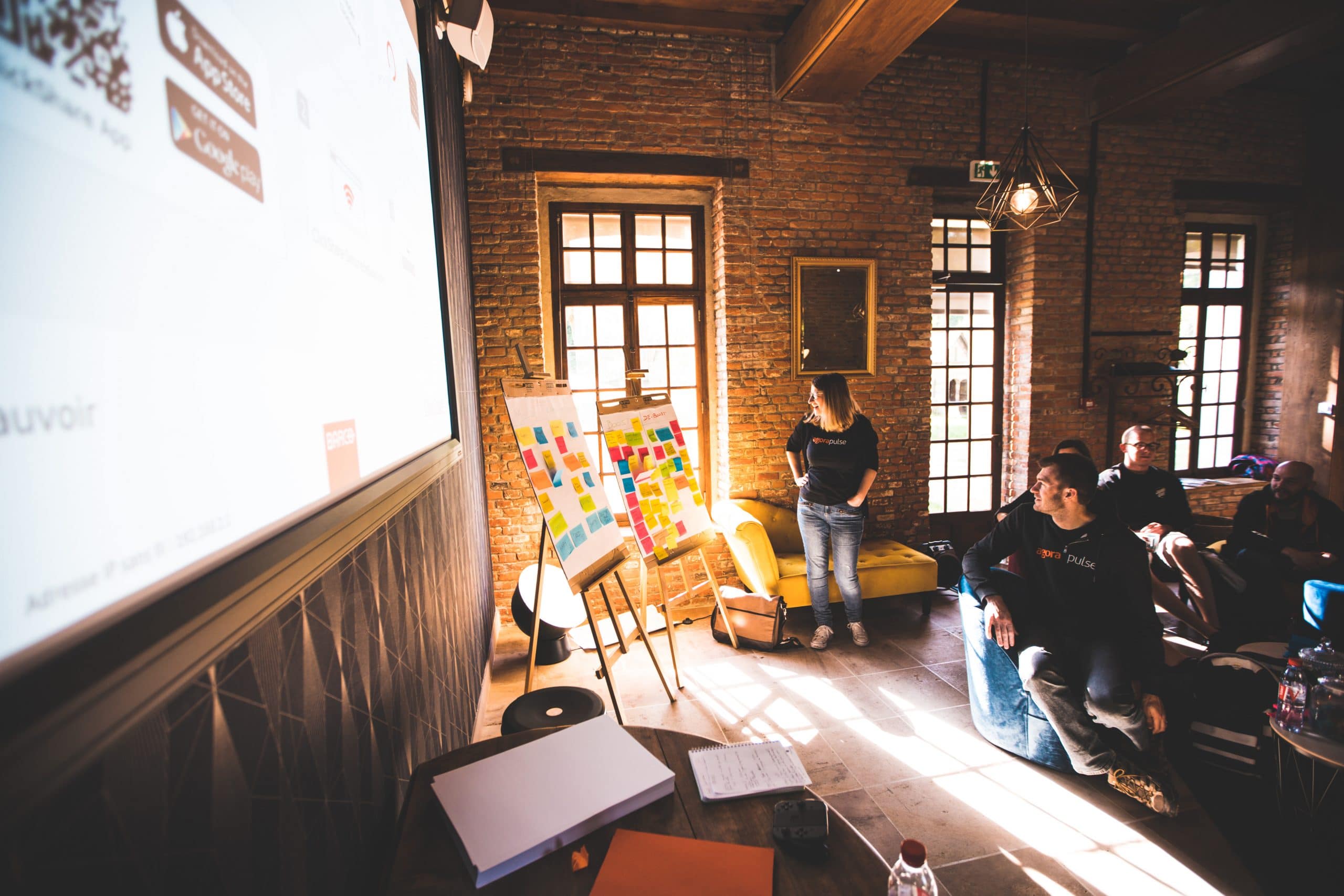Think of support teams, and you may picture rows and rows of endless desks with headphone-wearing businesspeople (No doubt, this image is influenced by all the boring “support” stock photos out there.) But a successful support team is far warmer and more vibrant than that. After all, they’re all about good communication skills and helpfulness.
At Agorapulse, we’ve had remote customer support since the company’s salad days, and it’s grown into something that customers rave about.
Recently, we asked Agorapulse’s head of Customer Support, Ineke Oates, and head of Customer Care, Kristell Cormarie, for their advice to companies who want (or need to) build their remote support team.
How to Build a Remote Support Team
Where are we today in terms of the Customer Care team?
Kristell: We offer support in four languages: French, English, Portuguese, and Spanish. We also have:
- Pure support: 13 people full-time
- Country managers: Four people in multi-capacities
- Customer Success: Five people
- We also have two people (Marcel and Paul) helping with the QA.
Ineke: All but the French team are remote. We currently have five English-speaking support team members, two (soon to be three) French Support team members, two APAC English-speaking team members, and also Support Spanish (two) and one Portuguese support team members. This is also supported by our amazing QA team, Paul and Marcel.
Download Now: FREE “Your Essential Guide to Remote Work” ebook
What is our approach to working remotely? How do we supervise the work? What about team responsibility?
Ineke: We all work remotely all week or, for the French team, some days of the week. All team members work full-time remote or part-remote (FR team) We all have specific inboxes to manage. Our VIP clients have as close as possible a dedicated team member who will look after them in their timezone.
Kristell: We have poles by region: APAC (Asia-Pacific), Europe, and the US, which allows us to do support on all time zones.
The responsibility of the inboxes to manage the tickets is shared according to several criteria: the language but also the level.
For example, we have a dedicated support inbox for VIP customers. Their requests will never be handled by a person on a trial. We want the “white glove” treatment for them. This does not prevent us from offering equally fast and professional service for other customers, of course!
How are people held accountable on a remote support team?
Kristell: The team has to respect shifts and communicate on its presence in the inbox (hence the famous “hello” or “lunch break” on Slack, a business communication platform) and update their Google calendar, so everyone is at the same level of information.
For example, a support hero should have a learning slot of one hour per week. It should be on the calendar. That way, there is no need to wonder if you don’t see that person in the inbox for an hour. It’s not micro-management but the best way to know how you can rely on others. The team has grown, so it’s necessary.
Ineke: Our own Slack channel is very active … We communicate more than most teams, saying hello, goodbye, lunchtime, etc. The inbox numbers speak for themselves. This is an easy indication to spot if everyone is doing their bit.
How do we supervise the work on our remote support team?
Kristell: We do this by:
- Reviewing on Klaus every day, based on set criteria defined together. It’s a pain-free way to do peer review in a professional, friendly, warm, and encouraging way while still offering valuable feedback.
- Reviewing customer notes
- Using Geekbot weekly for reporting (Results are then shared in the #ops-support channel on Slack.)
Responsibility is shown by responding quickly and well, with a maximum level of empathy and curiosity.
Supervision of the work is handled by giving weekly assignments. And we do a weekly update (renewal of annuals, contact for add-ons, churn management).
Ineke: In addition to what Kirstell said, we all communicate constantly. We say good morning in our Slack channel, we also say when we are stepping away from the inbox. It’s all about communication. We also have a weekly Monday meeting every week and a biweekly training call. I also have monthly one-on-one meetings with each team member.
Three out of five people are remote, so we’re used to this structure and process. There’s trust … We can see that the tasks are done on time. It’s just different [when remote] because the approach is a mix of reactivity and proactivity.
Responsibilities include welcoming new customers, training, listening to their needs, and passing them on to the product team.
How are people interviewed for these positions? (What are the desired characteristics of a remote worker, etc.)?
Kristell: Whether it is the CS or the support, we tend to want to work with someone who has already done remote work, who is used to it (like Amanda who joined us recently). Recruiting someone with 20 years of office life can be a miscalculation … Remote work is not for everyone.
Afterward, the criteria is linked to these four things:
- Soft skills related to the job. Empathy, curiosity, tech-savvy, “hand in the palm of your hand” spirit, listening skills, and writing skills
- Business knowledge. Having already done support or CS (knowing the practices, tools, etc.).
- Knowledge of the ecosystem. Having knowledge of social media is clearly a plus, but it can be learned.
- The culture fit. This is difficult to explain but the idea is to look at the values of the company and see if it matches (no ego, team player … ). Considering whether the potential hire will fit in with the rest of the team.
In the end, it is this last criterion that can tip the balance. Your gut feeling is critical to avoid making a mistake!
Ineke: Traits to look for include …
- Being able to work on their own initiative
- Being a team player, remembering that we are all together and one weak link will cause the team to suffer
When interviewing, generally people are looking for a remote job if they have already experienced this and like it. Having their own working space is vital, distractions can be an issue if you don’t.
They need to be able to work without getting distracted by little things, and know how important taking regular breaks are and being strict in taking them.
Being visible on what you are doing and where you are on your own learning curve is important, knowing when to ask for help is vital.
What resources do we use to maintain communication between team members of the remote support team?
Ineke: Slack is our tool of choice, using the notification settings to ensure we only get notified of what is important to us and knowing to turn on away mode when finishing your shift.
Kristell: Slack, daily update from Ineke for support, Tettra [an internal knowledge base and company wiki], weekly meeting, and weekly training with HighFive [videoconferencing platform].
How do we concretely deal with time zone differences?
Ineke: We have a 24-hour support team, starting with the EU team members who come online in the morning as the APAC team are finishing. We are then are joined by the US team later in the afternoon, who then are joined by the APAC team and so on. We have a good overlapping of the team so no one is on their own for any long period of time. This is important especially for remote teams. It can be lonely in general, but having another team member when you are online will always ease this.
We have daily updates for everyone to read at the start of their day, and this contains all the important notices that you need to have to start your day. It’s a must-read.
Kristell: Our team has a small overlap between each “pole” so that EN inboxes are never “dropped” during the week when the US starts, Europe can take its lunch break. When the US is done with their work (for people on the West Coast), the people in APAC have started one or two hours ago.
How do we handle emergencies as a remote support team?
Kristell: If we have a massive bug (whether it comes from us or from Facebook being down, for example,), we have set up a process in Tettra to handle it. We need to have such documentation in place for potential emergencies and situations to make communication run smoothly.
For example, at the moment, the CS is working to manage the COVID-19 crisis by providing the best possible support to affected customers.
Ineke: As we have a 24-hour support team, we have a manager in both EU and US timezones, so the teams are looked after, and also should any emergency happen we have our own steps to follow. We use Tettra for our internal knowledge base and all situations are documented so we know who is in charge of what.
What advice would you give someone who is managing a remote support team?
Ineke: Over-communicate … If you think you have given information to everyone, think again.
It’s important to document information and ensure everyone reads it. With Tettra, we can see if a team member has not opened the file and can and will remind them that this is an important step to their day.
Ensure you are having regular video call meetings where the team must have their video on. This helps everyone feel connected. Have virtual buddies, someone outside of their own team that they can turn to or reach out to.
Be available for your team.
In Conclusion
Stellar customer support doesn’t have to be in a call center. You can build, manage, and successfully grow your support team remotely, as you can see from the Agorapulse support team.
Take control of your social media! Check out our free trial of Agorapulse to help you schedule, track, and measure all your social media efforts.





![Feature image of How to Create a Healthy Feedback Culture [Definition + Practical Tips] Feature image of How to Create a Healthy Feedback Culture [Definition + Practical Tips]](https://static1.agorapulse.com/blog/wp-content/uploads/sites/2/2022/03/How-to-Create-a-Culture-of-Feedback-in-Your-Social-Media-Agency_V1_Blog-Feature.png)

